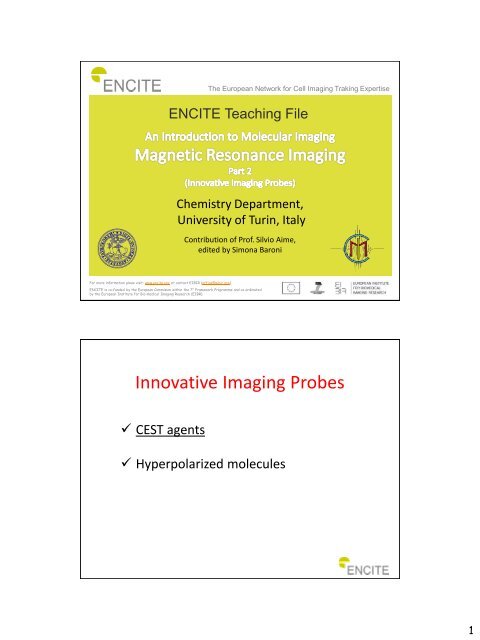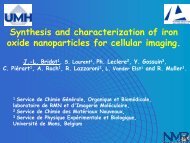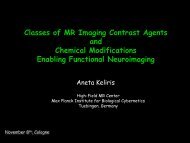Innovative Imaging Probes - Encite
Innovative Imaging Probes - Encite
Innovative Imaging Probes - Encite
Create successful ePaper yourself
Turn your PDF publications into a flip-book with our unique Google optimized e-Paper software.
The European Network for Cell <strong>Imaging</strong> Traking Expertise<br />
ENCITE Teaching File<br />
Chemistry Department,<br />
University of Turin, Italy<br />
Contribution of Prof. Silvio Aime,<br />
edited by Simona Baroni<br />
For more information pleae visit: www.encite.org or contact EIBIR (office@eibir.org).<br />
ENCITE is co-funded by the European Commision within the 7° Framework Programme and co-ordinated<br />
by the European Institute for Bio-medical <strong>Imaging</strong> Research (EIBR).<br />
<strong>Innovative</strong> <strong>Imaging</strong> <strong>Probes</strong><br />
CEST agents<br />
Hyperpolarized molecules<br />
1
CEST (Chemical Exchange Saturation Transfer) agents<br />
Dw (rad . Hz) = w WAT - w CEST<br />
If Dw > k ex then….<br />
CEST<br />
Agent<br />
w CEST<br />
w WAT<br />
water<br />
molecule<br />
CEST agent<br />
mobile protons<br />
-40 -30 -20 -10 0 10 20 30 40<br />
Dw<br />
KHz<br />
The MR-CEST experiment<br />
Aqueous solution of<br />
a CEST agent<br />
ON resonance<br />
irradiation<br />
I S<br />
rf field<br />
Bulk<br />
water<br />
I WAT = 16.9 a.u.<br />
I S = 7.8 a.u.<br />
-40 -30 -20 -10 0 10 20 30 40<br />
KHz<br />
CEST agent<br />
-40 -30 -20 -10 0 10 20 30 40<br />
KHz<br />
Dw Dw<br />
Drawback: the irradiation may decrease I WAT even<br />
in the absence of the CEST agent<br />
- direct saturation of bulk water signal<br />
- presence of immobilized mobile protons (in<br />
biological samples, ca. 100 KHz broad)<br />
Both these effects only depend on the absolute<br />
value of the irradiation frequency<br />
2
ST %<br />
The MR-CEST experiment<br />
Aqueous solution of<br />
a CEST agent<br />
ON resonance<br />
irradiation<br />
I S<br />
rf field<br />
Bulk<br />
water<br />
I WAT = 16.9 a.u.<br />
rf field<br />
I S = 7.8 a.u.<br />
-40 -30 -20 -10 0 10 20 30 40<br />
KHz<br />
I 0<br />
CEST agent<br />
-40 -30 -20 -10 0 10 20 30 40<br />
KHz<br />
Dw Dw<br />
OFF resonance<br />
irradiation<br />
I 0 = 14.5 a.u.<br />
-40 -30 -20 -10 0 10 20 30 40<br />
KHz<br />
ON-OFF<br />
difference image<br />
ST % = (1-I S /I 0 )*100<br />
46.2 %<br />
ST-weighted<br />
image<br />
CEST agents: the sensitivity issue<br />
The ST efficiency is proportional to the number of mobile protons<br />
100<br />
Simulated profiles* at 7 T<br />
Dw = 50 ppm<br />
80<br />
60<br />
k ex = 3300 s -1<br />
B 1 = 11.75 mT<br />
40<br />
20<br />
0<br />
0 50 100 150 200 250<br />
[mobile protons] - mM<br />
A ST of 10% requires a total concentration of mobile protons of few mM<br />
[CEST] agent =<br />
[mobile protons]<br />
number of mobile protons per molecule<br />
3
How to increase the number of mobile protons <br />
Use of nanoparticles<br />
Liposomes<br />
- well-known biocompatible systems<br />
- a liposome with 200 nm of diameter contains<br />
k ex<br />
about 2.410 8 mobile water protons!<br />
- k ex values cover a wide range (10-10 6 s -1 )<br />
depending on the chemical composition of<br />
the liposome membrane<br />
In order to act as CEST agent, the resonance frequency of<br />
the water protons inside the liposome must be shifted<br />
LIPOCEST agents: a new entry for highly-sensitive CEST probes<br />
The encapsulation of a paramagnetic shift reagent (SR) in liposomes<br />
affects the resonance frequency of the water protons inside the vesicle<br />
bulk<br />
water<br />
k ex<br />
SR<br />
Ln<br />
<br />
d wat-lip<br />
water<br />
inside lipos.<br />
40 30 20 10 0 -10 -20 -30 -40<br />
KHz<br />
d wat-lip depends on the type and concentration of SR<br />
k ex depends on the membrane composition and liposome size<br />
4
ST%<br />
SR<br />
LIPOCEST agents<br />
Hydration<br />
Vortexing<br />
MLV<br />
Extrusion<br />
SUV<br />
Dialysis<br />
55 °C<br />
55 °C<br />
Lipidic film<br />
SR unit<br />
Tm<br />
Water protons<br />
inside liposomes<br />
Bulk water<br />
1<br />
H-NMR spectrum (7 T, 298 K)<br />
[TmDOTMA] -<br />
0.12 M inside liposomes<br />
DPPC/DPPG 95/5 (w/w) liposomes<br />
LIPOCEST agents: sensitivity<br />
POPC/DPPG/Chol (55/5/40 w/w) liposomes<br />
312 K - [TmDOTMA] - 0.1 M – d WAT-LIP 3.2 ppm<br />
MR-CEST images<br />
(7 T - 312K - B 1 field 12 mT)<br />
60<br />
on-image<br />
off-image<br />
50<br />
40<br />
30<br />
20<br />
10<br />
1 8 0 3 6 0<br />
7 2 0<br />
90<br />
2 2 . 5<br />
1 4 4 0<br />
45<br />
0<br />
0 1000 2000 3000<br />
[liposome] - pM<br />
2 8 8 0<br />
on-off<br />
difference image<br />
The sensitivity is augmented to ca. 100 pM !<br />
5
LIPOCEST agents: passive tumor targeting in mice<br />
Liposomes can passively target tumors by exploiting the increased<br />
vascular permeability and the lack of an efficient lymphatic drainage<br />
But in order to prevent opsonisation processes and prolong blood lifetimes<br />
liposomes must be protected<br />
use of STEALTH Liposomes<br />
STEALTH Liposomes<br />
Liposome coated by PEG chains<br />
(t 1/2 in blood up to 3 days)<br />
Experimental set-up<br />
Animal model: Neuro 2A cells (murine neuroblastoma) inoculated<br />
subcutaneously to mice<br />
STEALTH LIPOCEST: POPC/Chol/DSPE-PEG (55/40/5) liposomes<br />
SR = [TmDOTMA] - - d WAT-LIP = 2.6 ppm<br />
diameter 110 nm<br />
LIPOCEST agents: passive tumor targeting in mice<br />
i.v administration of STEALTH LIPOCEST (dose: 0.04 mmol SR/kg)<br />
MR images at 7 T overlaid with ST-effects<br />
Pre-administration<br />
Tumoral region<br />
3 min post 30 min post<br />
24 h post<br />
6
<strong>Innovative</strong> <strong>Imaging</strong> <strong>Probes</strong><br />
CEST agents<br />
Hyperpolarized molecules<br />
What does “hyperpolarization” mean<br />
Normal Polarization:<br />
b<br />
a<br />
DN/N <br />
10 -5<br />
Low<br />
NMR<br />
sensitivity<br />
No field B 0<br />
Hyperpolarization:<br />
b<br />
a<br />
10 5<br />
enhancement<br />
in sensitivity<br />
No field B 0<br />
7
Routes to hyperpolarization<br />
Laser excitation ( 3 He or 129 Xe)<br />
“Brute Force”<br />
Dynamic Nuclear Polarization (DNP)<br />
Para-hydrogen Induced Polarization (PHIP)<br />
Laser-Polarized 3 He and 129 Xe<br />
h n<br />
Rb<br />
Rb<br />
Rb<br />
Rb<br />
Rb<br />
Rb<br />
Hyperpolarization<br />
of Rb atoms<br />
The radiation is circularly polarized;<br />
the Rb D1 line is used (corresponding<br />
to the 5s 1 -/ 25p transition)<br />
1 / 2<br />
Collisions between<br />
Rb and Xe<br />
Rb<br />
Xe<br />
(Van der Waals molecule)<br />
Polarization transfer to Xe atoms<br />
via “spin exchange”<br />
Xe<br />
Xe<br />
Xe<br />
8
Dynamic Nuclear Polarization (DNP)<br />
Solid material doped with unpaired<br />
electrons in a ratio of ~1:1000<br />
13<br />
C<br />
13<br />
13<br />
13<br />
C<br />
C<br />
C<br />
13 13<br />
C<br />
13<br />
13<br />
13<br />
C C<br />
C<br />
C<br />
13<br />
C e -<br />
13<br />
C<br />
13<br />
C<br />
13 13<br />
13<br />
13<br />
C<br />
C<br />
C C<br />
13<br />
13 C<br />
13<br />
C<br />
C<br />
13 13<br />
C<br />
13<br />
13 C<br />
C<br />
13<br />
C<br />
C<br />
13<br />
13<br />
C<br />
13 13<br />
C<br />
C<br />
C<br />
e -<br />
13<br />
C<br />
e -<br />
13<br />
C<br />
13<br />
C<br />
13<br />
13 13<br />
C<br />
C<br />
13<br />
C<br />
13 C<br />
13 C<br />
13<br />
C<br />
C<br />
13<br />
13<br />
C<br />
13 13 C<br />
C C<br />
13<br />
13 C<br />
13<br />
13 C<br />
C<br />
C<br />
13<br />
C<br />
13<br />
C<br />
P e = 94% and P C = 0.086%<br />
3.35 T and ~1.2K Microwaves transfer polarization<br />
from electrons to nuclei<br />
NMR and its Holy Grail<br />
PNAS 100, 10158-10163 (September 2003)<br />
< 1s<br />
65 h<br />
9
NMR and its Holy Grail<br />
<strong>Imaging</strong> 13 C-labelled urea in a rat<br />
Metabolic imaging of a rat tumor<br />
with hyperpolarized 13 C-pyruvate<br />
R3230AC,<br />
mammary<br />
adenocarcinoma<br />
1<br />
H-reference<br />
pyruvate<br />
alanine<br />
lactate<br />
10
Equilibrium p-H 2 percentage<br />
Para-hydrogen Induced Polarization<br />
(PHIP)<br />
What Para-Hydrogen is<br />
bb<br />
c(ab+ba)<br />
Triplet (ortho)<br />
aa<br />
c(ab-ba)<br />
Singlet (para)<br />
100<br />
80<br />
60<br />
Normal Hydrogen =<br />
75% ortho + 25% para<br />
40<br />
20<br />
0 100 200 300 400 500<br />
Temperature (K)<br />
Para-Hydrogen Induced Polarization<br />
(PHIP)<br />
D<br />
D<br />
H H<br />
D D<br />
d 5<br />
D<br />
+ p-H 2<br />
D<br />
d 5<br />
Resulting 1 H NMR spectrum:<br />
Ortho-H 2<br />
I = 0<br />
ab<br />
bb<br />
Para-H 2<br />
I = 0<br />
Para-H 2<br />
aa<br />
AX spin system<br />
ba<br />
Signal enhancement<br />
up to 10 5<br />
11
Para-H2 containing molecules<br />
as hyperpolarized contrast agents<br />
In order to obtain a 13 C image by<br />
using the 13 C polarized signal, it<br />
must be transformed from<br />
anthiphase to in-phase<br />
bbb<br />
bba<br />
FIELD CYCLING (ab+ba)b<br />
(ab+ba)b<br />
Earth magnetic field (50 mT)<br />
Non adiabatic (fast)<br />
Zero magnetic field<br />
(ab+ba)a<br />
(ab+ba)a<br />
aab<br />
aaa<br />
fast<br />
m-Metal<br />
The Nycomed approach: Para-H 2 containing<br />
molecules as hyperpolarized CA<br />
100% 13 C enriched<br />
Sub-second 13 C-angiography<br />
O<br />
O<br />
C C C C<br />
D 3 C O O C D 3<br />
p - H 2<br />
c a t .<br />
O<br />
O<br />
D 3 C O<br />
C<br />
C<br />
H<br />
C<br />
C *<br />
H<br />
O C D 3<br />
T 1 ( 13 C) = 75 s (7.05 T)<br />
normal spin echo (SE) image<br />
( 1 H) ( 13 C)<br />
single shot RARE sequence<br />
Magn. Res. In Med., 2001, 46, 1<br />
Targets for Molecular <strong>Imaging</strong><br />
Apps.gemedicalsystems.com<br />
13
Medical <strong>Imaging</strong> and range of detection<br />
CT/x-ray<br />
US<br />
MRI<br />
PET/NM<br />
Optical<br />
Anatomy Physiology Metabolism Molecular<br />
Gd-chelates<br />
Iron oxide<br />
particles<br />
Hyperpolarized<br />
13<br />
C-molecule<br />
CEST<br />
…a look at the market<br />
S truc tura l Im a ging 1 )<br />
22000<br />
20000 MID CAGR 4.8%<br />
18000 IT<br />
16000 MIA<br />
3200<br />
$ 21.9 bn<br />
3990<br />
1742<br />
Func tiona l/M ole c ula r Im a ging2 )<br />
24000<br />
22000<br />
20000<br />
18000<br />
16000 MID<br />
CAGR 11.5%<br />
$ 21.8 bn<br />
8823<br />
14000<br />
12000<br />
10000<br />
2451<br />
707<br />
1486<br />
16203<br />
14000<br />
12000<br />
10000<br />
IT<br />
MIA<br />
4444<br />
4065<br />
8000<br />
6000<br />
9926<br />
13350<br />
8000<br />
6000<br />
2222<br />
2229<br />
8917<br />
4000<br />
4000<br />
707<br />
5960<br />
2000<br />
2000<br />
3673<br />
0<br />
2000 2002 2004 2006 2008 2010<br />
2001<br />
2007<br />
2012<br />
0<br />
2000 2002 2004 2006 2008 2010<br />
2001<br />
2007<br />
2012<br />
Main drivers<br />
for growth<br />
• Ageing population<br />
(e.g.U.S., Europe, Japan)<br />
• Further penetration of<br />
unsatured markets<br />
(e.g.China, India)<br />
• Ageing population (e.g. U.S., Europe,<br />
Japan)<br />
• Broadening of indications for existing<br />
MIAs<br />
• Market entry of new MIA<br />
generations/categories<br />
• Technological improvement of MID<br />
14





